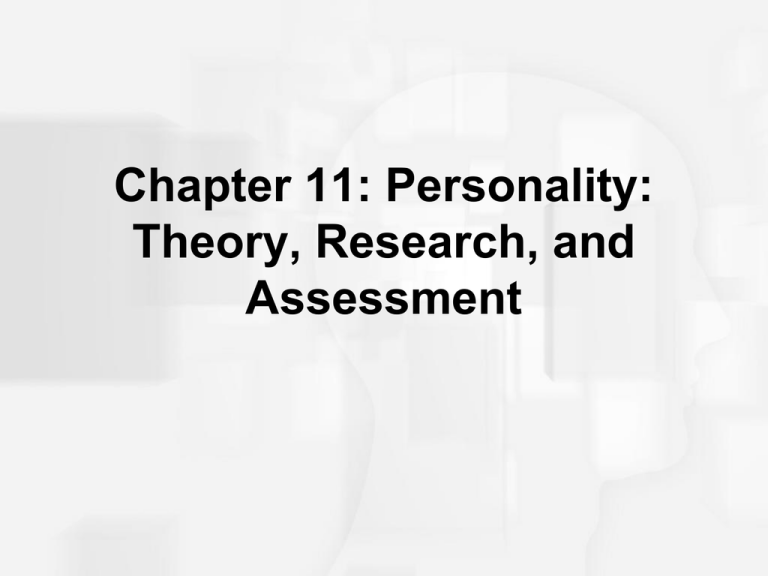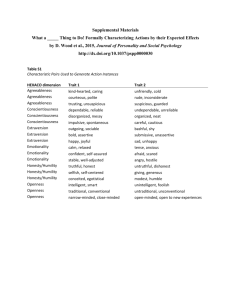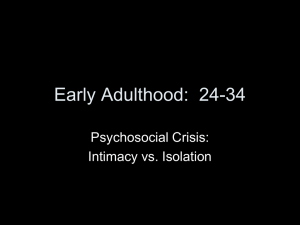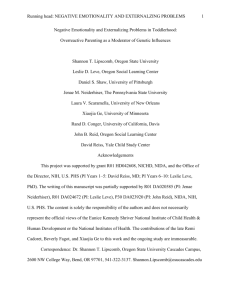
Chapter 11: Personality:
Theory, Research, and
Assessment
Defining Personality:
Consistency and Distinctiveness
• Personality Traits
– Dispositions
• The Five-Factor Model
– Extraversion
– Neuroticism
– Openness to experience
– Agreeableness
– Conscientiousness
outgoing
upbeat
Agreeableness
Neuroticism
(Negative
Emotionality)
Conscientiousness
Extraversion
(Constraint)
(Positive
Emotionality)
Extraversion
(Positive
Emotionality)
gregarious
assertive
Openness to
Experience
friendly
sociable
anxious
Agreeableness
Neuroticism
(Negative
Emotionality)
insecure
Conscientiousness
Neuroticism(Constraint)
(Negative
Emotionality)
Extraversion
(Positive
Emotionality)
hostile
vulnerable
Openness to
Experience
self-conscious
curiosity
Agreeableness
artistic sensitivity
Neuroticism
(Negative
Emotionality)
flexibility
Conscientiousness
(Constraint)
Openness to
Experience
imaginativeness
Extraversion
(Positive
Emotionality)
vivid fantasy
Openness to
Experience
unconventional attitudes
sympathetic
Agreeableness
modest
Neuroticism
(Negative
Emotionality)
trusting
Conscientiousness
(Constraint)
Agreeableness
cooperative
Extraversion
(Positive
Emotionality)
Openness to
Experience
straight forward
diligent
Agreeableness
punctual
Neuroticism
Conscientiousness
(Negative
(Constraint)
Emotionality)Conscientiousness
(Constraint)
dependable
Extraversion
(Positive
Emotionality)
Openness to
Experience
well-organized
disciplined
Psychodynamic Perspectives
• Freud’s psychoanalytic theory
– Conflict
• Sex and Aggression
• Anxiety
• Defense Mechanisms
Psychodynamic Perspectives
• Freud’s psychoanalytic theory
– Structure of personality
• Id - Pleasure principle
• Ego - Reality principle
• Superego – Morality
EGO
Gratify Urges
Immediately
ID
Holds Urges
in Check With Reality
Holds Urges in
Check With
Morality
Superego
Psychodynamic Perspectives
• Freud’s psychoanalytic theory
– Levels of awareness
• Conscious
• Unconscious
• Preconscious
Figure 11.2 Freud’s model of personality structure
Figure 11.3 Freud’s model of personality dynamics
Table 11.1 Defense Mechanisms, with Examples
Freud on Development:
Psychosexual Stages
• Sexual = physical pleasure
• Psychosexual stages
– Oral – (0-1)
– Anal (2-3)
– Phallic (3-5)
• Oedipus / Electra Complex
– Latency (5-12)
– Genital (Adolescence)
• Fixation = Excessive gratification or
frustration
Table 11.2 Freud’s Stages of Psychosexual Development
Other Psychodynamic Theorists
• Carl Jung: Analytical Psychology
– Personal and collective unconscious
– Archetypes
Personal and Collective Unconscious
Collective Unconscious
Person
A
Conscious
Person
B
Person
C
Personal
Unconscious
Figure 11.4 Jung’s vision of the collective unconscious
Other Psychodynamic Theorists
• Alfred Adler: Individual Psychology
– Striving for superiority
– Compensation
Evaluating Psychodynamic Perspectives
• Pros
– The unconscious
– The role of internal conflict
– The importance of early childhood
experiences
– The use of defense mechanisms
• Cons
– Poor testability
– Inadequate empirical base
– Sexist views
Behavioral Perspectives
• Skinner’s views
– Conditioning and
response tendencies
Figure 11.5 A behavioral view of personality
Behavioral Perspectives
• Bandura’s social cognitive theory
– Observational learning
– Models
– Self-efficacy
Figure 11.6 Personality development and operant conditioning
Evaluating Behavioral Perspectives
• Pros
– Based on rigorous research
– Insights into effects of learning and
environmental factors
• Cons
– Over-dependence on animal research
– Fragmented view of personality
– Dehumanizing views
Humanistic Perspectives
• Carl Rogers’s person-centered
theory
– Self-concept
• Conditional/unconditional
positive regard
• Incongruence and anxiety
Figure 11.7 Rogers’s view of personality structure
Figure 11.8 Rogers’s view of personality development and dynamics
Humanistic Perspectives
• Abraham Maslow’s theory of self-actualization
– Hierarchy of needs
– The healthy personality
Figure 11.9 Maslow’s hierarchy of needs
Figure 11.10 Maslow’s view of the healthy personality
Evaluating Humanistic Perspectives
• Pros
– Recognized importance of subjective views
– Recognized importance of self-concept
– Laid foundation for positive psychology
• Cons
– Many aspects of theory are difficult to test
– Unrealistic optimism
– More empirical research needed
Biological Perspectives
• Eysenk’s theory
– Determined by genes
– Extraversion-introversion
• Behavioral genetics
– Twin studies
– Heritability estimates
• The evolutionary approach
– Traits conducive to reproductive fitness
Figure 11.11 Eysenck’s model of personality structure
Evaluating Biological Perspectives
• Pros
– Convincing evidence for genetic influence
• Cons
– Too much reliance on heritability estimates
– No comprehensive biological theory












